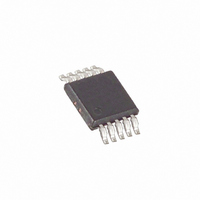MAX669EUB+ Maxim Integrated Products, MAX669EUB+ Datasheet - Page 9

MAX669EUB+
Manufacturer Part Number
MAX669EUB+
Description
IC PWM BST FLYBCK ISO CM 10UMAX
Manufacturer
Maxim Integrated Products
Datasheet
1.MAX669EUB.pdf
(18 pages)
Specifications of MAX669EUB+
Pwm Type
Current Mode
Number Of Outputs
1
Frequency - Max
575kHz
Duty Cycle
94%
Voltage - Supply
1.8 V ~ 28 V
Buck
No
Boost
Yes
Flyback
Yes
Inverting
No
Doubler
No
Divider
No
Cuk
No
Isolated
Yes
Operating Temperature
-40°C ~ 85°C
Package / Case
10-MSOP, Micro10™, 10-uMAX, 10-uSOP
Frequency-max
575kHz
Output Current
6 A
Switching Frequency
500 KHz
Operating Supply Voltage
1.8 V to 28 V
Supply Current
0.22 mA
Maximum Operating Temperature
+ 85 C
Minimum Operating Temperature
- 40 C
Mounting Style
SMD/SMT
Output Voltage
3 V to 28 V
Duty Cycle (max)
94 %
Synchronous Pin
Yes
Topology
Boost, Flyback
Lead Free Status / RoHS Status
Lead free / RoHS Compliant
The heart of the MAX668/MAX669 current-mode PWM
controller is a BiCMOS multi-input comparator that
simultaneously processes the output-error signal, the
current-sense signal, and a slope-compensation ramp
(Figure 1). The main PWM comparator is direct sum-
ming, lacking a traditional error amplifier and its associ-
ated phase shift. The direct summing configuration
approaches ideal cycle-by-cycle control over the output
voltage since there is no conventional error amp in the
feedback path.
In PWM mode, the controller uses fixed-frequency, cur-
rent-mode operation where the duty ratio is set by the
input/output voltage ratio (duty ratio = (V
in the boost configuration). The current-mode feedback
loop regulates peak inductor current as a function of
the output error signal.
At light loads the controller enters Idle Mode. During
Idle Mode, switching pulses are provided only as need-
ed to service the load, and operating current is mini-
mized to provide best light-load efficiency. The
minimum-current comparator threshold is 15mV, or 15%
of the full-load value (I
troller is synchronized to an external clock, Idle Mode
occurs only at very light loads.
Figure 1. MAX668/MAX669 Functional Diagram
CS+
1.25V
FB
100mV
15mV
CURRENT SENSE
_______________________________________________________________________________________
SLOPE COMPENSATION
MAX
ANTISAT
I
I
MAX
MIN
) of 100mV. When the con-
V
CC
R1
552k
R2
276k
R3
276k
LDO
PWM Controller
1.8V to 28V Input, PWM Step-Up
+C
+A
-A X6
-C X1
+S
-S
OUT
X1
MAIN PWM
COMPARATOR
- V
UVLO
IN
) / V
MAX669 ONLY
IN
Several IC biasing options, including bootstrapped and
non-bootstrapped operation, are made possible by an
on-chip, low-dropout 5V regulator. The regulator input is
at V
functions, including EXT, are internally powered from
LDO. The V
200mV (300mV max at 12mA), so that when V
than 5.2V, LDO is typically V
in dropout, the MAX668/MAX669 still operate with V
as low as 3V (as long as LDO exceeds 2.7V), but with
reduced amplitude FET drive at EXT. The maximum
V
LDO can supply up to 12mA to power the IC, supply
gate charge through EXT to the external FET, and sup-
ply small external loads. When driving particularly large
FETs at high switching rates, little or no LDO current
may be available for external loads. For example, when
switched at 500kHz, a large FET with 20nC gate charge
requires 20nC x 500kHz, or 10mA.
V
optimize efficiency, circuit quiescent current, and full-
load start-up behavior for different input and output
voltage ranges. Connections are shown in Figures 2, 3,
4, and 5. The characteristics of each are outlined in
Table 1.
Bootstrapped/Non-Bootstrapped Operation
CC
CC
SYNC/SHDN
CC
input voltage is 28V.
and LDO allow a variety of biasing connections to
1.25V
, while its output is at LDO. All MAX668/MAX669
EXT
Controllers in µMAX
FREQ
CC
PGND
LDO
-to-LDO dropout voltage is typically
REF
MUX
OSC
BIAS
Low-Dropout Regulator (LDO)
0
1
MAX668
MAX669
CC
- 200mV. When LDO is
OSC
S Q
R
(MAX669 ONLY)
LOW-VOLTAGE
OSCILLATOR
START-UP
CC
is less
CC
9












